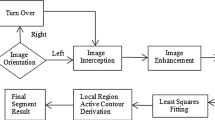Abstract
In computer-aided diagnosis (CAD) of mediolateral oblique (MLO) view of mammogram, the accuracy of tissue segmentation highly depends on the exclusion of pectoral muscle. Robust methods for such exclusions are essential as the normal presence of pectoral muscle can bias the decision of CAD. In this paper, a novel texture gradient-based approach for automatic segmentation of pectoral muscle is proposed. The pectoral edge is initially approximated to a straight line by applying Hough transform on Probable Texture Gradient (PTG) map of the mammogram followed by block averaging with the aid of approximated line. Furthermore, a smooth pectoral muscle curve is achieved with proposed Euclidean Distance Regression (EDR) technique and polynomial modeling. The algorithm is robust to texture and overlapping fibro glandular tissues. The method is validated with 340 MLO views from three databases—including 200 randomly selected scanned film images from miniMIAS, 100 computed radiography images and 40 full-field digital mammogram images. Qualitatively, 96.75 % of the pectoral muscles are segmented with an acceptable pectoral score index. The proposed method not only outperforms state-of-the-art approaches but also accurately quantifies the pectoral edge. Thus, its high accuracy and relatively quick processing time clearly justify its suitability for CAD.











Similar content being viewed by others
References
Ferrari R, Rangayyan R, Borges R, Frere A: Segmentation of the fibro-glandular disc in mammograms using Gaussian mixture modeling. Med Biol Eng Comput 42(3):378–387, 2004
Eklund GW, Cardenosa G, Parsons W: Assessing adequacy of mammographic image quality. Radiology 190(2):297–307, 1994
Saha PK, Udupa JK, Conant EF, Chakraborty DP, Sullivan D: Breast tissue density quantification via digitized mammograms. IEEE Trans Med Imaging 20:792–803, 2001
Gupta R, Undrill PE: The use of texture analysis to delineate suspicious masses in mammography. Phys Med Biol 40:835–855, 1995
Karssemeijer N: Automated classification of parenchymal patterns in mammograms. Phys Med Biol 43:365–378, 1998
Aylward SR, Hemminger BM, Pisano ED: In: Karssemeijer N, et al Eds. Mixture modeling for digital mammogram display and analysis. Digital Mammography, Comput Imag and Vision Series, vol. 13. Kluwer Academic Publishers, Dordrecht, 1998, pp 305–312
Ferrari RJ, Rangayyan RM, Desautels JEL, Frere AF: Segmentation of mammograms: Identification of the skin—air boundary, pectoral muscle, and fibro-glandular disc. In: Yaffe MJ, Ed. IWDM 2000. Proc. 5th Int Workshop Digital Mammography, Toronto, ON, Canada, 573-579, 2001
Kinoshita SK, Azevedo Marques PM, Pereira Jr, RR, Rodrigues JA, Rangayyan RM: Radon-domain detection of the nipple and the pectoral muscle in mammograms. J Digit Imaging 21(1):37–49, 2008
Ferrari RJ, Rangayyan RM, Desautels JEL, Borges RA, Frere AF: Automatic identification of the pectoral muscle in mammograms. IEEE Trans Med Imaging 23(2):232–245, 2004
Kwok SM, Chandrasekhar R, Attikiouzel Y, Rickard MT: Automatic pectoral muscle segmentation on mediolateral oblique view mammograms. IEEE Trans Med Imaging 23(9):1129–1140, 2004
Raba D, Oliver A, Marti J, Peracaula M, Espunya J: Breast segmentation with pectoral muscle suppression on digital mammograms. Pattern Recog and Image Anal, Lecture Notes in Computer Science, vol. 3523. Springer, Berlin Heidelberg, 2005, pp 471–478
Ma F, Bajger M, Slavotinek JP, Bottema MJ: Two graph theory based methods for identifying the pectoral muscle in mammograms. Pattern Recogn 40(9):2592–2602, 2007
Zhou C, Wei J, Chan H, Paramagul C, Hadjiiski L, Sahiner B, Douglas J: Computerized image analysis: texture-field orientation method for pectoral muscle identification on MLO-view mammograms. Med Phys 37(5):2289–2299, 2010
Chakraborty J, Mukhopadhyay S, Singla V, Khandelwal N, Bhattacharyya P: Computerized image analysis: texture-field orientation method for pectoral muscle identification on MLO-view mammograms. J Digit Imaging 25:387–399, 2012
Suckling J, Parker J, Dance D, Astley S, Hutt I, Boggis C, Ricketts I, Stamatakis E, Cerneaz N, Kok S, et al: The mammographic image analysis society digital mammogram database, Exerpta Medical. Int Congr Ser 1069:375–378, 1994
Mustra M, Grgic M: Robust automatic breast and pectoral muscle segmentation from scanned mammograms. Signal Process 93(10):2817–2827, 2013
Jain AK: Fundamentals of Digital Image Processing Prentice Hall Information and System Sciences Series. Prentice Hall, NJ, USA, 1989
Zuiderveld K: Contrast limited adaptive histogram equalization. Graphic gems IV. Academic Press Professional, San Diego, 1994, pp 474–485
Gonzalez RC, Woods RE: Digital image processing, 3rd edition. Pearson Prentice Hall, New Jersey, 2008
Motulsky HJ, Christopoulos A: Fitting models to biological data using linear and nonlinear regression. A practical Guide to Curve Fitting. GraphPad Software Inc., San Diego CA, www.graphpad.com, 2003
Kwok SM: Attribute-driven segmentation and analysis of mammograms. Ph.D. dissertation: University of Western Australia- School of Electrical, Electronic and Computer Engineering, and Centre for Intelligent Information Processing Systems. Ch 4-5, 2004
Morrow WM, Paranjape RB, Rangayyan R, Desautels JEL: Region-based contrast enhancement of mammograms. IEEE Trans Med Imaging 11(3):392–406, 1992
Acknowledgments
The authors would like to thank Dr. Varsha S. Hardas, Consultant Radiologist of Star Imaging & Research Centre, Pune, India, for providing FFDM images and assessing the segmentation results. Thanks is also given to Dr Suchitra Mehta, Central India Cancer Research Institute (CICRI), Nagpur, India, for providing CR Mammograms and also for assessing segmentation results. We also acknowledge the financial support provided by Centre of Excellence on Combedded System: Hybridization of Communication and Embedded Systems under TEQIP 1.2.1 at VNIT, Nagpur.
Author information
Authors and Affiliations
Corresponding author
Rights and permissions
About this article
Cite this article
Bora, V.B., Kothari, A.G. & Keskar, A.G. Robust Automatic Pectoral Muscle Segmentation from Mammograms Using Texture Gradient and Euclidean Distance Regression. J Digit Imaging 29, 115–125 (2016). https://doi.org/10.1007/s10278-015-9813-5
Published:
Issue Date:
DOI: https://doi.org/10.1007/s10278-015-9813-5




